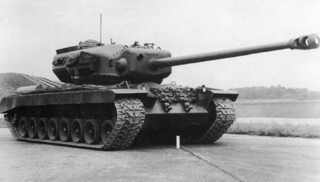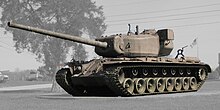
The M4 Sherman, officially Medium Tank, M4, was the most widely used medium tank by the United States and Western Allies in World War II. The M4 Sherman proved to be reliable, relatively cheap to produce, and available in great numbers. It was also the basis of several other armored fighting vehicles including self-propelled artillery, tank destroyers, and armored recovery vehicles. Tens of thousands were distributed through the Lend-Lease program to the British Commonwealth and Soviet Union. The tank was named by the British after the American Civil War General William Tecumseh Sherman.

The M26 Pershing is a heavy tank/medium tank formerly used by the United States Army. It was used in the last months of World War II during the Invasion of Germany and extensively during the Korean War. The tank was named after General of the Armies John J. Pershing, who led the American Expeditionary Force in Europe in World War I.
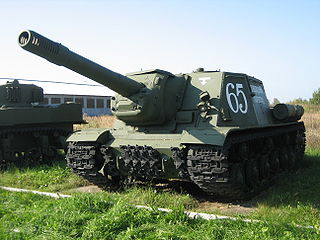
The ISU-152 is a Soviet self-propelled gun developed and used during World War II. It was unofficially nicknamed Zveroboy in response to several large German tanks and guns coming into service, including Tigers and Panthers. Since the ISU-152's gun was mounted in a casemate, aiming it was awkward, and had to be done by repositioning the entire vehicle using the tracks. Therefore, it was used as mobile artillery to support more mobile infantry and armor attacks. It continued service into the 1970s and was used in several campaigns and countries.

The T28 Super Heavy Tank was an American super-heavy tank/assault gun designed for the United States Army during World War II. It was originally designed to break through German defenses of the Siegfried Line and was later considered as a possible participant in the planned invasion of the Japanese mainland.
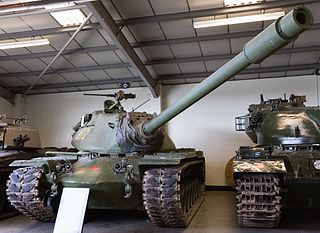
The M103 Heavy Tank was a heavy tank that served in the United States Army and the United States Marine Corps during the Cold War. Introduced in 1957, it served through 1974, by which time evolution of the concept of a main battle tank considered heavy tanks obsolete.

The 75 mm gun, models M2 to M6, was the standard American medium caliber gun fitted to mobile platforms during World War II. They were primarily mounted on tanks, such as the M3 Lee and M4 Sherman, but one variant was also used as an air-to-ground gun on the B-25 Mitchell medium bomber aircraft. There were five main variants used during the war: M2, M3, M4, M5 and M6.

The T95 was an American prototype medium tank developed from 1955 to 1959. These tanks used many advanced or unusual features, such as siliceous-cored armor, new transmissions, and OPTAR fire-control systems. The OPTAR incorporated an electro-optical rangefinder and was mounted on the right side of the turret, and was used in conjunction with the APFSDS-firing 90 mm T208 smoothbore gun, which had a rigid mount without a recoil system. In addition, although the tanks were designed with a torsion beam suspension, a hydropneumatic suspension was fitted, and one of the tanks was fitted with a Solar Saturn gas turbine for demonstration purposes.
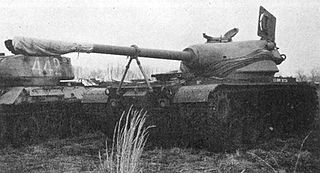
The T54 was a series of prototype American tanks of the 1950s with three different turrets, all armed with a 105 mm gun, mounted on the M48 Patton chassis. The T54 had a conventional turret with an autoloader with 3 shells, the T54E1 had an oscillating design with an autoloader, and the T54E2 had a conventional turret with a human loader.

The Heavy Tank T30 was a World War II American tank project developed to counter new German tanks, such as Tiger I, Tiger II, and tank destroyers, such as the Jagdtiger, or Soviet heavy tanks, such as IS-2 or IS-3. The T30 was designed at the same time as the T29 Heavy Tank.
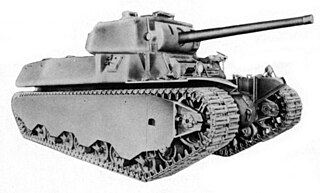
The Heavy Tank M6 was an American heavy tank designed during World War II. The tank was produced in small numbers and never saw combat.

The 120 mm Gun M1 was the United States Army's standard super-heavy anti-aircraft gun during World War II and the Korean War, complementing the smaller and more mobile M2 90 mm gun in service. Its maximum altitude was about 60,000 ft (18,000 m), which earned it the nickname stratosphere gun.

The 76 mm gun M1 was an American World War II–era tank gun developed by the U.S United States Ordnance Department in 1942 to supplement the 75 mm gun on the basic Medium tank M4. It was also used to arm the M18 Hellcat tank destroyer.

The United States has produced tanks since their inception in World War I, up until the present day. While there were several American experiments in tank design, the first American tanks to see service were copies of French light tanks and a joint heavy tank design with the United Kingdom.

The Light Tank, T1 was a United States Army light tank of the late 1920s and early 1930s that was only built in prototype form. The tank was an Army design built by James Cunningham, Son and Company. Introduced in 1927, it was developed up through 1932 as a series of modified versions. The tank was never mass-produced, nor was it ever used in combat.

The T30 Howitzer Motor Carriage (HMC) was a United States Army self-propelled gun used in World War II. Its design was based on requirements for an assault gun issued by the Armored Force in 1941 and it was built as an interim solution until a fully tracked design was complete.
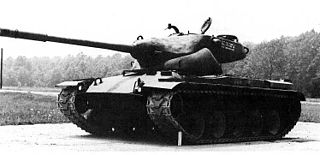
The T57 heavy tank was an experimental heavy tank developed by the American military during the Cold War era as a further development of the M103 heavy tank. Featuring heavy armor and a long range 120 mm rifled gun, the T57 was supposed to serve as a replacement to the M103 in service with American heavy tank units in Europe. Armor on the hull front was to range between 5–8 in (130–200 mm) in thickness and the turret was to be 5.98 in (152 mm) at maximum on all sides. Like the French AMX 50 project, it was to feature an oscillating turret and was also to receive a 153 mm gun. Experiments were also conducted to investigate mounting a 203 mm gun, but this was soon found to be infeasible. When multiple problems were discovered in the turret oscillation system on account of the excess weight of the heavily armored turret and the gun, the project was dropped.

The 120 mm Gun Tank T110 was a cancelled heavy tank project which began in June 1954. It was an attempt to improve the T43 heavy tank project. Restrictions were placed on the vehicle sizing as the tank was supposed to pass through the narrow tunnels of the Bernese Alps, but none of the proposals actually met these restrictions. Development was cancelled due to the redundancy and due to the satisfactory results of the T43(M103). It was intended to be built by Chrysler, but no vehicles were ever manufactured. The tank was planned to be powered by a Continental AVI-1790-8 engine power plant delivering around 875 hp or Continental AOI-1490-1 delivering around 700 hp. The original T110 tank was a proposal created by Detroit Arsenal, and was introduced in a Detroit conference held in June 1954. Of many tank designs, the T110 TS31, was favored.

The 155mm L/40 T7 was an American rifled tank gun developed in 1945. The T7 was to be the main armament for the T30 Heavy Tank, but only a handful were produced due to the T30 project being cancelled after trials in the late 1940s.
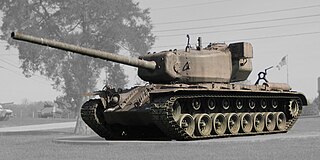
The 105mm L/65 T5 was an American rifled anti-tank gun developed in 1945. The T5E1 was the main armament for several American WWII heavy tanks designs, including the double-tracked T28 Super Heavy Tank and T29 Heavy Tank.

The T34 Heavy Tank was an American design for a heavy tank. It evolved from the T29 Heavy Tank and T30 Heavy Tank in 1945, using the same chassis, but sporting a 120 mm (4.72 in) modified 120 mm Gun M1 anti-aircraft gun. Extra armor plating was applied to the rear of the turret bustle as a counterweight for the heavier 120mm T53 main gun. No production orders were placed for the T34, which was felt to be too heavy.
